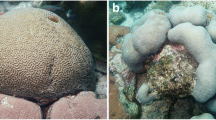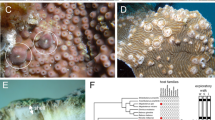Abstract
The distribution, size and reproductive characteristics of the snail Coralliophila violacea (Lamarck), which inhabits the surface of both the branching coral Porites nigrescens and the massive corals P. lobata and P. lutea, were surveyed to examine the host effect on: (1) population structure and (2) reproductive characteristics, including the size at sex change of symbionts. On branching hosts, most snails were solitary, whereas on massive hosts, most had formed multiple-snail patches. Significantly smaller snails as well as proportionally more females were found on branching than on massive hosts. Furthermore, the fecundity of the females on the branching hosts was significantly lower than that on the massive hosts. The size at sex change (male to female) of the snails was smaller on the branching hosts than on massive hosts. Patch composition differences can partly explain the smaller size at sex change for snails on branching hosts; however, there was also evidence that host morphology had a significant effect on the timing of sex change.







Similar content being viewed by others
References
Charnov EL (1979) Natural selection and sex change in pandalid shrimp: test of a life history theory. Am Nat 113:715–734
Charnov EL (1981) Sex reversal in Pandalus borealis: effect of a shrimp fishery. Mar Biol Lett 2:53–57
Charnov EL (1982) The theory of sex allocation. Princeton University Press, Princeton, N.J.
Charnov EL, Bull JJ (1989) Non-Fisherian sex ratios with sex change and environmental sex determination. Nature 338:148–150
Chen MH, Soong K (2002) Estimation of age in the sex-changing, coral-inhabiting snail Coralliophila violacea (Lamarck) from the growth striae on opercula and a mark–recapture experiment. Mar Biol 142:337–342
Chen MH, Yang YW, Soong K (1998) Preliminary observations on change of sex by the coral-inhabiting snails Coralliophila violacea (Lamarck) (Gastropoda: Coralliophilidae). J Exp Mar Biol Ecol 230:207–212
Coe WR (1953) Influences of association, isolation, and nutrition on the sexuality of snails of the genus Crepidula. J Exp Zool 122:5–19
Collin R (1995) Sex, size, and position: a test of models predicting size at sex change in the protandrous gastropod Crepidula fornicata. Am Nat 146:815–831
Connell JH (1973) Population ecology of reef-building corals. In: Jones OA, Endean R (eds) Population ecology of reef-building corals, vol 2. Academic, New York, pp 205–245
Dai CF, Yang HP (1995) Distribution of Spirobranchus giganteus corniculatus (Hove) on the coral reefs of southern Taiwan. Zool Stud 34:117–125
Demond J (1957) Micronesian reef-associated gastropods. Pac Sci 11:275–341
Fujioka Y, Yamazato K (1983) Host selection of some Okinawan coral associated gastropods belonging to the genera Drupella, Coralliophila and Quoyula. Galaxea 2:59–73
Ghiselin MT (1969) The evolution of hermaphroditism among animals. Q Rev Biol 44:189–208
Hadfield MG (1976) Molluscs associated with living tropical corals. Micronesica 12:133–148
Hayes JA (1989) The biology and ecology of Coralliophila abbreviata Lamarck (gastropod, Coralliophilidae): the importance of corallivores in the ecology of coral reefs. PhD dissertation, University of Texas, Austin
Hayes JA (1990) Distribution, movement and impact of the corallivorous gastropod Coralliophila abbreviata (Lamarck) on a Panamanian patch reef. J Exp Mar Biol Ecol 142:25–42
Hoagland KE (1978) Protandry and the evolution of environmentally-mediated sex change: a study of the Mollusca. Malacologia 17:365–391
Hunte W, Marsden JR, Conlin BE (1990) Habitat selection in the tropical polychaete Spirobranchus giganteus. III. Effects of coral species on body size and body proportions. Mar Biol 104:101–107
Iwasa Y (1991) Sex change evolution and cost of reproduction. Behav Ecol 2:56–68
Lin TY, Liu PJ (1995) Fecundity of female coral-inhabiting snails, Coralliophila violacea (Gastropoda: Coralliophilidae). Veliger 38:319–322
McClanahan TR (1994) Coral-eating snail Drupella cornus population increases in Kenyan coral reef lagoons. Mar Ecol Prog Ser 115:131–137
Miller AC (1981) Cnidarian prey of the snails Coralliophila abbreviata and C. caribaea (Gastropoda: Muricidae) in Discovery Bay, Jamaica. Bull Mar Sci 31:932–934
Oliverio M, Mariottini P (2001) Contrasting morphological and molecular variation in Coralliophila meyendorffii (Muricidae, Coralliophilinae). J Moll Stud 67:243–246
Policansky D (1982) Sex change in plants and animals. Annu Rev Ecol Syst 13:471–495
Robertson R (1970) Review of the predators and parasites of stony corals, with special reference to symbiotic prosobranch gastropods. Pac Sci 24:43–54
Robertson R (1980) Epitonium millecostatum and Coralliophila clathrata: two prosobranch gastropods symbiotic with Indo-Pacific Palythoa (Coelenterata: Zoanthidae). Pac Sci 34:1–17
Rogers L, Sargent RC (2001) A dynamic model of size-dependent reproductive effort in a sequential hermaphrodite: a counterexample to Williams’ conjecture. Am Nat 158:543–552
Soong K, Chen JL (1991) Population structure and sex-change in the coral-inhabiting snail Coralliophila violacea at Hsiao-Liuchiu, Taiwan. Mar Biol 111:81–86
Taylor JD (1968) Coral reef and associated invertebrate communities (mainly molluscan) around Mahe, Seychelles. Philos Trans R Soc Lond B Biol Sci 254:129–206
Taylor JD (1971) Reef associated molluscan assemblages in the western Indian Ocean. Symp Zool Soc Lond 28:501–534
Taylor JD (1978) Habitats and diet of predatory gastropods at Addu Atool, Maldives. J Exp Mar Biol Ecol 31:83–100
Warner RR (1975) The adaptive significance of sequential hermaphroditism in animals. Am Nat 109:61–82
Warner RR (1984) Deferred reproduction as a response to sexual selection in a coral reef fish: a test of the life historical consequences. Evolution 38:148–162
Warner RR (1988) Sex change and the size-advantage model. Trends Ecol Evol 3:133–136
Warner RR, Fitch DL, Standish JD (1996) Social control of sex change in the shelf limpet, Crepidula norrisiarum: size-specific responses to local group composition. J Exp Mar Biol Ecol 204:155–167
Wells FE, Lalli CM (1977) Reproduction and brood protection in the Caribbean gastropods Coralliophila abbreviata and C. caribaea. J Moll Stud 43:79–87
Wright WG (1988) Sex change in the Mollusca. Trends Ecol Evol 3:137–140
Acknowledgements
The authors wish to thank H. Jiang, J.R. Cao, T.A. Chen and Y.W. Yang for helping with field collections and two anonymous reviewers for valuable comments. This field work was made possible through the facilities at the Kenting Marine Station, National Sun Yat-sen University. This investigation was supported by a grant from the National Science Council (NSC90-2611-B-110-001 and NSC90-2311-B-291-004), Taiwan, Republic of China.
Author information
Authors and Affiliations
Corresponding author
Additional information
Communicated by T. Ikeda, Hakodate
Rights and permissions
About this article
Cite this article
Chen, MH., Soong, K. & Tsai, ML. Host effect on size structure and timing of sex change in the coral-inhabiting snail Coralliophila violacea . Marine Biology 144, 287–293 (2004). https://doi.org/10.1007/s00227-003-1204-7
Received:
Accepted:
Published:
Issue Date:
DOI: https://doi.org/10.1007/s00227-003-1204-7




